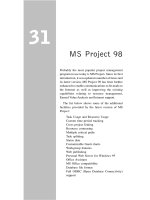Project CloseOut and Termination
Bạn đang xem bản rút gọn của tài liệu. Xem và tải ngay bản đầy đủ của tài liệu tại đây (226.88 KB, 18 trang )
Project Close-Out and
Termination
Chapter 14
Copyright © 2010 Pearson Education, Inc. Publishing as Prentice Hall
14-1
Project Termination
All activities consistent with closing out the project
Extinction
Addition
Integration
Starvation
Copyright © 2010 Pearson Education, Inc. Publishing as Prentice Hall
14-2
Termination by extinction
• The project may end because it has been successful
and achieved its goals
• The project may also be stopped because it is
unsuccessful or has been superseded
• When a decision is made to terminate a project by
extinction, the most noticeable event is that all activity
on the substance of the project ceases
Examples:
1. The product has been developed and handed over to the
client.
2. The building has been completed and accepted by the owner
Copyright © 2010 Pearson Education, Inc. Publishing as Prentice Hall
14-3
Termination by addition
• If a project is a major success, it may be
terminated by institutionalizing it as a formal part
of the parent organization
• Project personnel, property, and equipment are
often simply transferred from the dying project to
the newly born division
Copyright © 2010 Pearson Education, Inc. Publishing as Prentice Hall
14-4
Termination by integration
• •This method of terminating projects is the most
common way of dealing with successful projects,
and the most complex
• • The property, equipment, material, personnel,
and functions of the project are reintegrated into
within the existing structure of the parent
organization
Copyright © 2010 Pearson Education, Inc. Publishing as Prentice Hall
14-5
Termination by starvation
• This type of project termination is a “slow
starvation by budget decrement”
• A form of neglect by slowly decreasing the
budget to the point that the project cannot
possibly remain viable.
Copyright © 2010 Pearson Education, Inc. Publishing as Prentice Hall
14-6
Elements of Project
Closeout Management
Harvesting
Gaining
Finishing Handing
Acceptance the Benefits
Over
the
The Work
Product
for the
Reviewing
Product
How
It All Went
Putting it All to Bed
Disbanding the Team
Copyright © 2010 Pearson Education, Inc. Publishing as Prentice Hall
14-7
Lessons Learned Meetings
Common Errors
Misidentifying systematic errors
Misinterpreting lessons based on events
Failure to pass along conclusions
Meeting Guidelines
Establish clear rules of behavior
Describe objectively what occurred
Fix the problem, not the blame
Copyright © 2010 Pearson Education, Inc. Publishing as Prentice Hall
14-8
Closeout Paperwork
•
Documentation
•
Legal
•
Cost
•
Personnel
Copyright © 2010 Pearson Education, Inc. Publishing as Prentice Hall
14-9
Why are Closeouts Difficult?
Project sign off can be a de-motivator
Constraints cause shortcuts on back-end
Low priority activities
Lessons learned analysis seen as bookkeeping
Unique view of projects
Copyright © 2010 Pearson Education, Inc. Publishing as Prentice Hall
14-10
Early Warning Signs of Project Failure
• Lack of viable commercial objectives
• Lack of sufficient authority to make decisions
• New product developed for stable market
• Low priority assigned to the project by
management
Copyright © 2010 Pearson Education, Inc. Publishing as Prentice Hall
14-11
Early Termination Decision Rules
Costs exceed business benefits
Failure to meet strategic fit criteria
Deadlines continue to be missed
Technology evolves beyond the project’s scope
Copyright © 2010 Pearson Education, Inc. Publishing as Prentice Hall
14-12
The Top 10 Signs of IT Project Failure
10. Best practices and lessons learned are ignored
9. Project lacks people with appropriate skills
8. Sponsorship is lost
7. Users are resistant
6. Deadlines are unrealistic
5. Business needs change
4. Chosen technology changes
3. Project changes are poorly managed
2. Scope is ill-defined
1. Project managers don’t understand users’ needs
Copyright © 2010 Pearson Education, Inc. Publishing as Prentice Hall
14-13
Project Termination Issues
Emotional
Staff
Client
Intellectual
Internal
Copyright © 2010 Pearson Education, Inc. Publishing as Prentice Hall
External
14-14
Claims & Disputes
Two types of claims
• Ex-gratia claims
• Default by the project company
Resolved by
• Arbitration
– Binding
– Non-binding
•
Standard litigation
Copyright © 2010 Pearson Education, Inc. Publishing as Prentice Hall
14-15
Protecting Against Claims
o Consider claims as part of the project plan
o Verify stakeholders know their risks
o Keep good records throughout the life cycle
o Keep clear details of change orders
o Archive all correspondence
Copyright © 2010 Pearson Education, Inc. Publishing as Prentice Hall
14-16
Final Report Elements
Project performance
Administrative performance
Organizational structure
Team performance
Project management techniques
Benefits to the organization and customer
Copyright © 2010 Pearson Education, Inc. Publishing as Prentice Hall
14-17
Copyright © 2010 Pearson Education, Inc. Publishing as Prentice Hall
14-18









